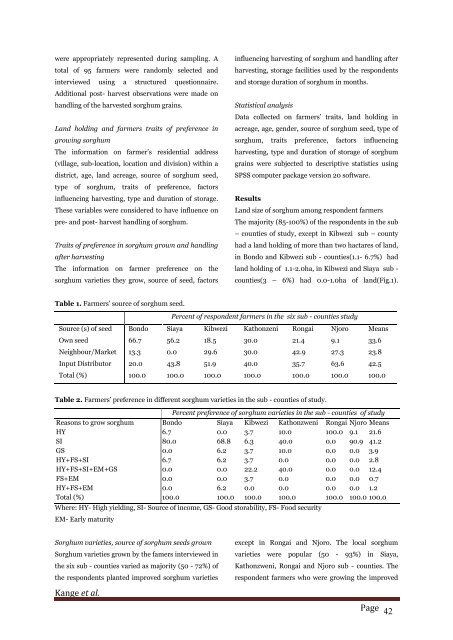Pre- and post harvest factors affecting sorghum production (Sorghum bicolor L. Moench) among smallholder farming communities
A farm survey was conducted on Sorghum (Sorghum bicolor L. Moench) as a staple cereal crop adapted in arid and semi – arid lands. The objective was to determine pre - and post - harvest factors affecting sorghum production. Ninety five farmers were sampled using snowballing sampling method in six sorghum growing sub –counties (Siaya, Bondo, Njoro, Rongai, Kibwezi and Kathonzweni) to gather information on pre - and post – harvest. Data collected on source of sorghum seeds, varieties storage form and were analyzed using descriptive statistic cross tabulation SPSS version 20 software. Sources of sorghum seed were farmers own seed (33.7%), from neighbour or market (24.2%) and farm input distributors (42.1%). The results showed that 44.2% and 55.8% of the farmers preferred local and improved sorghum varieties respectively. Sorghum grains were either stored in shelled form (88.4%) or on panicles (11.6%). This study further established that farmers maintain a diversity of sorghum landraces unique in their adaptation, food quality, grain yield and quality of harvested products resistance. The results of this study can be used to explain the perennial food insecurity in these regions known to have huge potential for sorghum production. http://www.innspub.net/volume-5-number-4-october-2014-ijaar/
A farm survey was conducted on Sorghum (Sorghum bicolor L. Moench) as a staple cereal crop adapted in arid and semi – arid lands. The objective was to determine pre - and post - harvest factors affecting sorghum
production. Ninety five farmers were sampled using snowballing sampling method in six sorghum growing sub –counties (Siaya, Bondo, Njoro, Rongai, Kibwezi and Kathonzweni) to gather information on pre - and post – harvest. Data collected on source of sorghum seeds, varieties storage form and were analyzed using descriptive statistic cross tabulation SPSS version 20 software. Sources of sorghum seed were farmers own seed (33.7%),
from neighbour or market (24.2%) and farm input distributors (42.1%). The results showed that 44.2% and 55.8% of the farmers preferred local and improved sorghum varieties respectively. Sorghum grains were either
stored in shelled form (88.4%) or on panicles (11.6%). This study further established that farmers maintain a diversity of sorghum landraces unique in their adaptation, food quality, grain yield and quality of harvested
products resistance. The results of this study can be used to explain the perennial food insecurity in these regions known to have huge potential for sorghum production.
http://www.innspub.net/volume-5-number-4-october-2014-ijaar/
Create successful ePaper yourself
Turn your PDF publications into a flip-book with our unique Google optimized e-Paper software.
were appropriately represented during sampling. A<br />
total of 95 farmers were r<strong>and</strong>omly selected <strong>and</strong><br />
interviewed using a structured questionnaire.<br />
Additional <strong>post</strong>- <strong>harvest</strong> observations were made on<br />
h<strong>and</strong>ling of the <strong>harvest</strong>ed <strong>sorghum</strong> grains.<br />
L<strong>and</strong> holding <strong>and</strong> farmers traits of preference in<br />
growing <strong>sorghum</strong><br />
The information on farmer’s residential address<br />
(village, sub-location, location <strong>and</strong> division) within a<br />
district, age, l<strong>and</strong> acreage, source of <strong>sorghum</strong> seed,<br />
type of <strong>sorghum</strong>, traits of preference, <strong>factors</strong><br />
influencing <strong>harvest</strong>ing, type <strong>and</strong> duration of storage.<br />
These variables were considered to have influence on<br />
pre- <strong>and</strong> <strong>post</strong>- <strong>harvest</strong> h<strong>and</strong>ling of <strong>sorghum</strong>.<br />
Traits of preference in <strong>sorghum</strong> grown <strong>and</strong> h<strong>and</strong>ling<br />
after <strong>harvest</strong>ing<br />
The information on farmer preference on the<br />
<strong>sorghum</strong> varieties they grow, source of seed, <strong>factors</strong><br />
influencing <strong>harvest</strong>ing of <strong>sorghum</strong> <strong>and</strong> h<strong>and</strong>ling after<br />
<strong>harvest</strong>ing, storage facilities used by the respondents<br />
<strong>and</strong> storage duration of <strong>sorghum</strong> in months.<br />
Statistical analysis<br />
Data collected on farmers’ traits, l<strong>and</strong> holding in<br />
acreage, age, gender, source of <strong>sorghum</strong> seed, type of<br />
<strong>sorghum</strong>, traits preference, <strong>factors</strong> influencing<br />
<strong>harvest</strong>ing, type <strong>and</strong> duration of storage of <strong>sorghum</strong><br />
grains were subjected to descriptive statistics using<br />
SPSS computer package version 20 software.<br />
Results<br />
L<strong>and</strong> size of <strong>sorghum</strong> <strong>among</strong> respondent farmers<br />
The majority (85-100%) of the respondents in the sub<br />
– counties of study, except in Kibwezi sub – county<br />
had a l<strong>and</strong> holding of more than two hactares of l<strong>and</strong>,<br />
in Bondo <strong>and</strong> Kibwezi sub - counties(1.1- 6.7%) had<br />
l<strong>and</strong> holding of 1.1-2.0ha, in Kibwezi <strong>and</strong> Siaya sub -<br />
counties(3 – 6%) had 0.0-1.0ha of l<strong>and</strong>(Fig.1).<br />
Table 1. Farmers’ source of <strong>sorghum</strong> seed.<br />
Percent of respondent farmers in the six sub - counties study<br />
Source (s) of seed Bondo Siaya Kibwezi Kathonzeni Rongai Njoro Means<br />
Own seed 66.7 56.2 18.5 30.0 21.4 9.1 33.6<br />
Neighbour/Market 13.3 0.0 29.6 30.0 42.9 27.3 23.8<br />
Input Distributor 20.0 43.8 51.9 40.0 35.7 63.6 42.5<br />
Total (%) 100.0 100.0 100.0 100.0 100.0 100.0 100.0<br />
Table 2. Farmers’ preference in different <strong>sorghum</strong> varieties in the sub - counties of study.<br />
Percent preference of <strong>sorghum</strong> varieties in the sub - counties of study<br />
Reasons to grow <strong>sorghum</strong> Bondo Siaya Kibwezi Kathonzweni Rongai Njoro Means<br />
HY 6.7 0.0 3.7 10.0 100.0 9.1 21.6<br />
SI 80.0 68.8 6.3 40.0 0.0 90.9 41.2<br />
GS 0.0 6.2 3.7 10.0 0.0 0.0 3.9<br />
HY+FS+SI 6.7 6.2 3.7 0.0 0.0 0.0 2.8<br />
HY+FS+SI+EM+GS 0.0 0.0 22.2 40.0 0.0 0.0 12.4<br />
FS+EM 0.0 0.0 3.7 0.0 0.0 0.0 0.7<br />
HY+FS+EM 0.0 6.2 0.0 0.0 0.0 0.0 1.2<br />
Total (%) 100.0 100.0 100.0 100.0 100.0 100.0 100.0<br />
Where: HY- High yielding, SI- Source of income, GS- Good storability, FS- Food security<br />
EM- Early maturity<br />
<strong>Sorghum</strong> varieties, source of <strong>sorghum</strong> seeds grown<br />
<strong>Sorghum</strong> varieties grown by the famers interviewed in<br />
the six sub - counties varied as majority (50 - 72%) of<br />
the respondents planted improved <strong>sorghum</strong> varieties<br />
except in Rongai <strong>and</strong> Njoro. The local <strong>sorghum</strong><br />
varieties were popular (50 - 93%) in Siaya,<br />
Kathonzweni, Rongai <strong>and</strong> Njoro sub - counties. The<br />
respondent farmers who were growing the improved<br />
Kange et al.<br />
Page 42


















